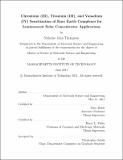| dc.contributor.advisor | Marc Baldo and Harry L. Tuller. | en_US |
| dc.contributor.author | Thompson, Nicholas John | en_US |
| dc.contributor.other | Massachusetts Institute of Technology. Dept. of Materials Science and Engineering. | en_US |
| dc.date.accessioned | 2012-03-16T14:42:39Z | |
| dc.date.available | 2012-03-16T14:42:39Z | |
| dc.date.copyright | 2011 | en_US |
| dc.date.issued | 2011 | en_US |
| dc.identifier.uri | http://hdl.handle.net/1721.1/69674 | |
| dc.description | Thesis (S.M.)--Massachusetts Institute of Technology, Dept. of Materials Science and Engineering, 2011. | en_US |
| dc.description | This electronic version was submitted by the student author. The certified thesis is available in the Institute Archives and Special Collections. | en_US |
| dc.description | Cataloged from PDF version of thesis. | en_US |
| dc.description | Includes bibliographical references (p. 56-59). | en_US |
| dc.description.abstract | High optical concentrations without excess heating in a stationary system can be achieved with a luminescent solar concentrator (LSC). Neodymium (Nd) and ytterbium (Yb) are excellent infrared LSC materials: inexpensive, abundant, efficient, and spectrally well-matched to high-performance silicon solar cells. These rare earth ions are reasonably transparent to their own radiation and capable of generating high optical concentrations. Neodymium's and ytterbium's disadvantage is their relatively poor absorption overlap with the visible spectrum. Transition metals such as chromium (Cr), titanium (Ti), and vanadium (V) have broadband absorption covering the visible and near-infrared and can efficiently sensitize neodymium and ytterbium through a non-radiative energy transfer process. Chromium, titanium, and vanadium containing glasses were fabricated using a custom designed glass making furnace. The optical properties including molar absorption coefficient, photoluminescence spectrum, and energy transfer characteristics were investigated to determine the suitability for LSC applications. Glasses containing Cr or V co-doped with Nd or Yb demonstrated energy transfer from the transition metal to the rare earth, a fundamental step toward integration into a LSC. Titanium co-doped glasses did not exhibit photoluminescence or energy transfer. Chromium co-doped glasses exhibit both forward and backward energy transfer. Vanadium holds the best promise as a sensitizer for LSC applications. | en_US |
| dc.description.statementofresponsibility | by Nicholas John Thompson. | en_US |
| dc.format.extent | 59 p. | en_US |
| dc.language.iso | eng | en_US |
| dc.publisher | Massachusetts Institute of Technology | en_US |
| dc.rights | M.I.T. theses are protected by
copyright. They may be viewed from this source for any purpose, but
reproduction or distribution in any format is prohibited without written
permission. See provided URL for inquiries about permission. | en_US |
| dc.rights.uri | http://dspace.mit.edu/handle/1721.1/7582 | en_US |
| dc.subject | Materials Science and Engineering. | en_US |
| dc.title | Chromium (III), Titanium (III), and Vanadium (IV) sensitization of rare earth complexes for luminescent solar concentrator applications | en_US |
| dc.type | Thesis | en_US |
| dc.description.degree | S.M. | en_US |
| dc.contributor.department | Massachusetts Institute of Technology. Department of Materials Science and Engineering | |
| dc.identifier.oclc | 777957117 | en_US |
